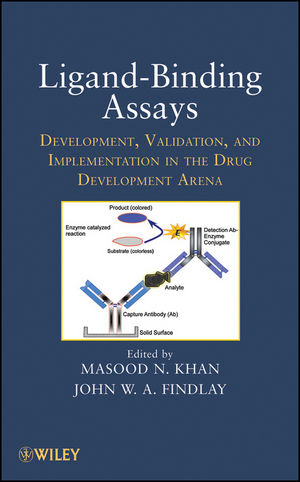Ligand-Binding Assays: Development, Validation, and Implementation in the Drug Development ArenaISBN: 978-0-470-04138-3
Hardcover
424 pages
November 2009
 |
||||||
Contributors.
1 Ligand-Binding Assays in Drug Development: Introduction and Historical Perspective (John W.A. Findlay and Masood N. Khan).
1.1 General.
1.2 Historical Review.
1.3 LBAs for Macromolecules.
1.4 Advantages and Limitations of LBAs.
1.5 Ligand-Binding Assay Bioanalytical Focus Group of AAPS.
1.6 Scope of the Present Volume.
References.
2 Ligand-Binding Assays to Support Disposition Studies of Macromolecular Therapeutics (Marian M. Kelley, Marjorie A. Mohler, and John W.A. Findlay).
2.1 Introduction.
2.2 Differences Between Low Molecular Weight Molecules and Macromolecules.
2.3 LBA Assay Considerations Relative to Research and Development Stage.
2.4 Critical Future Challenges for Ligand-Binding Assays.
2.5 Conclusions.
References.
3 Development of Ligand-Binding Assays for Drug Development Support (Masood N. Khan, Proveen D. Dass, John H. Leete, Richard F. Schuman, Michele Gunsior, and Chanchal Sadhu).
3.1 Introduction.
3.2 Inherent Complexities of Immunoassay Development.
3.3 Steps in the Development of a Validatable Immunoassay.
3.4 Development and Optimization of an Immunoassay.
3.5 Optimization of Commercial Kit-Based Assays.
3.6 Troubleshooting Immunoassays.
3.7. Conclusions.
Acknowledgments.
References.
4 Validation of Ligand-Binding Assays to Support Pharmacokinetic Assessments of Biotherapeutics (Binodh S. DeSilva and Ronald R. Bowsher).
4.1 Introduction.
4.2 Assay Development and Validation Paradigm.
4.3 Prestudy Validation Phase.
4.4 Analytical Performance Characteristics.
4.5 In-Study Validation Phase.
4.6 Partial Validations/Method Transfer/Cross-Validation.
4.7 Documentation.
4.8 Conclusions.
References.
5 Statistical Considerations in the Validation of Ligand-Binding Assays (Bruno Boulanger, Viswanath Devanarayan, and Walthère Dewé).
5.1 Introduction.
5.2 Objectives of Assay Validation.
5.3 Validation Criteria.
5.4 Estimating Assay Performance Characteristics.
5.5 Decision Rules and Risk Assessment in Prestudy Validation.
5.6 Decision Rules During In-Study Phase and Associated Risks.
5.7 Reconciling Validation and Routine Decision Rules.
5.8 Conclusions.
References.
6 Development and Validation of Ligand-Binding Assays for Biomarkers (Jean W. Lee, Yang Pan, Peter J. O’Brien, and Ren Xu).
6.1 Introduction.
6.2 Preanalytical Considerations and Method Feasibility.
6.3 Method Development and Method Qualification for Exploratory Applications.
6.4 Method Development and Method Validation for Advanced Applications.
6.5 Partial Validation for Change Control.
6.6 Documentation, Record Keeping, and Reporting.
6.7 Regulatory Issues.
6.8 In-study Validation.
6.9 Conclusions.
Acknowledgments.
References.
7 The Use of Commercial Assay Kits for PK/PD Analysis in Drug Development (John L. Allinson and John D. Chappell).
7.1 Introduction.
7.2 Validation Definitions That May be Interpreted Inconsistently.
7.3 Validation Experiments.
7.4 Stability.
7.5 Reoptimizing Reagent Concentrations.
7.6 The Use of Commercial Kits for PK and TK Assays.
7.7 Matrix Problems.
7.8 Changing Method Protocol.
7.9 Conclusions.
References.
8 Development and Validation of Immunogenicity Assays for Preclinical and Clinical Studies (Thomas H. Parish, Deborah Finco, and Viswanath Devanarayan).
8.1 Introduction.
8.2 Immunogenicity Risk-Based Strategy.
8.3 Regulatory Guidance.
8.4 Assay Design.
8.5 Optimization and Validation: Total Binding Antibody Assays.
8.6 Optimization and Validation: Neutralizing Antibody Assays.
8.7 Assays and Risk Assessment.
8.8 Application and Interpretation of Data.
8.9 Conclusions.
8.10 Appendix 8.A Illustration of Screening Cut Point Evaluation.
References.
9 Macromolecular Reference Standards for Biotherapeutic Pharmacokinetic Analysis (Marie T. Rock and Stephen Keller).
9.1 Introduction.
9.2 United States Pharmacopeia.
9.3 Characterization of Non-USP Reference Standards.
9.4 The PK Assay.
9.5 Conclusions.
References.
10 Strategies for Successful Transfer of Ligand-Binding Assays for Successful Validation and Implementation in GXP Environment (Wolfgang Klump and Howard Hill).
10.1 Introduction.
10.2 Establishing Successful Working Relationships Between Laboratories.
10.3 Method Transfer.
10.4 Monitoring the Method Transfer Process.
10.5 Auditing CROs.
10.6 Method Troubleshooting.
10.7 Secrets of Successful Method Transfer.
Acknowledgments.
References.
11 Application of Automation in Ligand-Binding Assays (Chris Morrow).
11.1 Introduction.
11.2 Implementing Automated Systems.
11.3 Specific Ligand-Binding Assay Automation Systems.
11.4 Automated Sample Dilutors.
11.5 Assay Robots.
11.6 Integration: Tying It All Together.
11.7 Future Directions in Ligand-Binding Assay Automation.
11.8 Conclusion.
Acknowledgments.
References.
12 Documentation and Regulatory Compliance (CT. Viswanathan and Jacqueline A. O’Shaughnessy).
12.1 Regulatory Perspectives in the Documentation of Bioanalytical Data and Reports.
12.2 Recommendations for Development, Validation, Implementation, and Reporting Phases.
12.3 Conclusions.
References.
13 Alternative and Emerging Methodologies in Ligand-Binding Assays (Huifen F. Wang and John W.A. Findlay).
13.1 Introduction.
13.2 Dissociation-Enhanced Lanthanide Fluoroimmunoassay.
13.3 Enzyme-Linked Immunospot Assay.
13.4 Immuno-Polymerase Chain Reaction.
13.5 Electrochemiluminescence-Based Ligand-Binding Assays.
13.6 Hybridization-Based Ligand-Binding Assays.
13.7 Molecularly Imprinted Polymers (Synthetic Antibodies).
13.8 Surface Plasmon Resonance Methods.
13.9 Chromatography–Ligand-Binding Assay Coupled Methods, Immunoaffinity Systems, and Online (Flow-Injection) Ligand-Binding Assay Methods.
13.10 Future Trends and Directions for LBATechnologies.
13.11 Conclusions.
Acknowledgment.
References.
Index.



